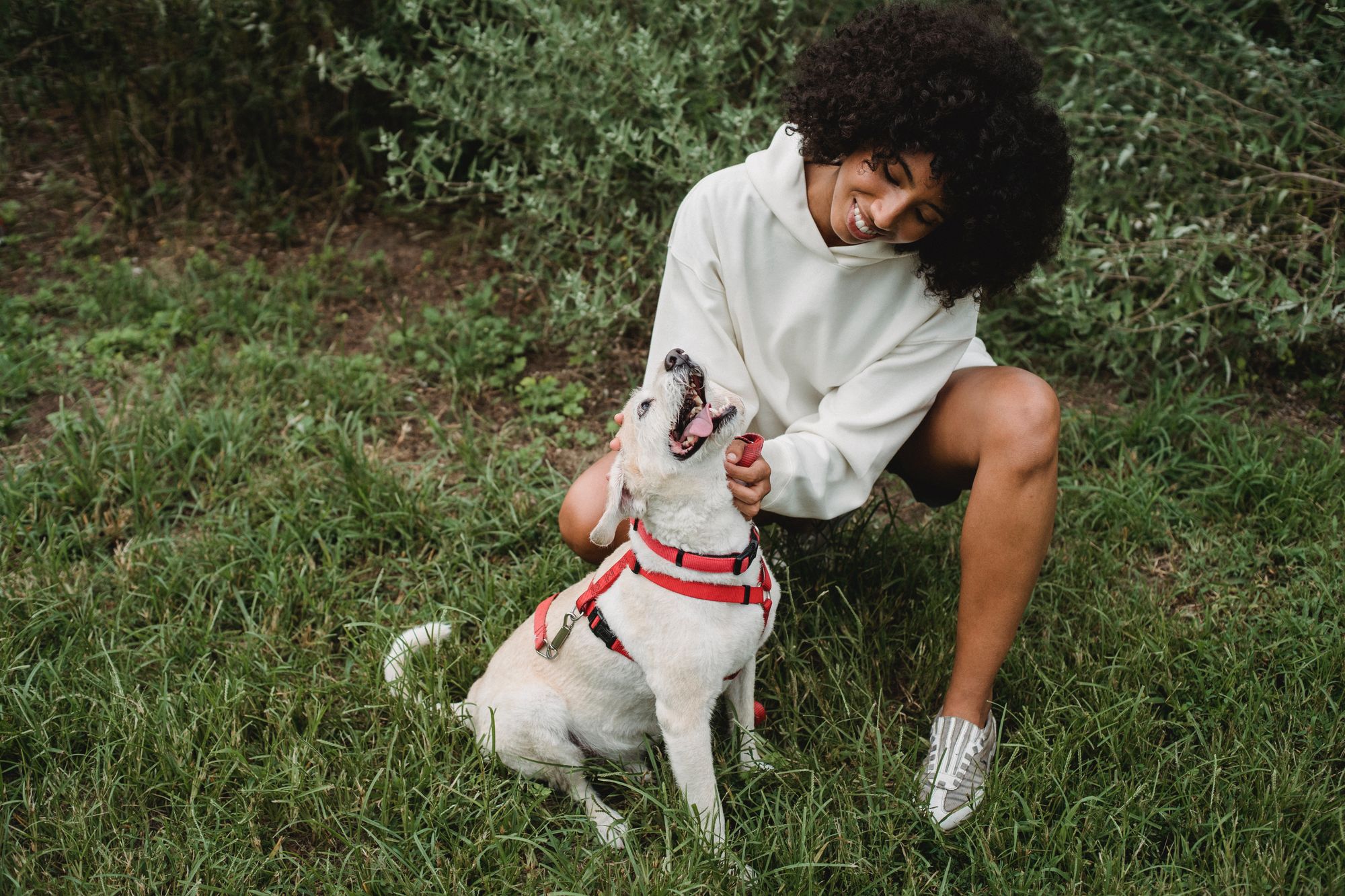Finding a lost dog without a collar can be a concerning situation for any animal lover. On one hand, you've come across a helpless pup that clearly needs assistance, but on the other hand, there's no immediate way to contact its owner. You're now faced with a moral and sometimes legal obligation to ensure the dog's safety while attempting to locate its home.
The lack of a collar complicates the process, making the standard avenues of identification, such as tags or a phone number, unavailable. In such scenarios, it's crucial to approach the situation methodically and cautiously. Your actions could make all the difference in ensuring the dog's well-being and eventual reunion with its family.
In this guide, we'll walk you through the essential steps you should take when you find a lost dog without a collar. From capturing the dog safely to using social media as a tool for identification, we've got you covered. Let's embark on this journey of canine rescue, ensuring you're well-equipped to handle this delicate situation.
Contact Local Animal Control or Shelter
If the dog is approachable and does not have identification, contact your local animal control or shelter. Provide them with a detailed description of the dog, including its breed, size, and any unique markings. They will guide you on the next steps to ensure the dog's safety and further attempts to locate the owner. By following these initial steps, you can take the necessary actions to provide assistance to the lost dog and help reunite it with its owner. Remember to prioritize the dog's safety and well-being while attempting to locate the owner or provide temporary care.
Assess the Situation
Evaluating the circumstance is vital when encountering a lost dog without a collar. Take note of the dog's behavior to understand its temperament and potential level of danger. Observe if the dog is calm or distressed, and whether it approaches or avoids people.
- Check for injuries: Examine the dog thoroughly to identify any visible injuries or signs of illness. Look for limping, open wounds, or abnormal behavior. If the dog seems injured, approach cautiously to prevent further harm.
- Look for identification: Even if the dog lacks a collar, there might still be a way to determine the owner. Search for any tags, tattoos, or microchips on the dog's body. If no identification is found, consider taking the dog to a local veterinarian or animal shelter where they can scan for a microchip.
- Assess the environment: Take into account the surroundings where the dog was found. Are there any nearby busy roads or hazards that could endanger the dog? Consider whether it is safe to keep the dog in its current location or if it should be moved to a more secure area.
- Seek assistance: Depending on the situation, it may be necessary to seek help from animal control, a local shelter, or a rescue organization. They can provide guidance on the next steps to take and may be able to reunite the dog with its owner.
By carefully assessing the situation, you can determine the best course of action to ensure the lost dog's safety and increase the chances of finding its owner. Remember, each situation is unique, so use your judgment and prioritize the well-being of the dog.

Is the Dog Approachable?
When you come across a lost dog without a collar, the first thing you need to determine is whether the dog is approachable or not. Is the dog approachable? This will help you decide on the next steps to take. Here are some factors to consider:
- Body language: Assess the dog's body language to see if it appears relaxed, friendly, and open. Signs of approachability include a loose wagging tail, relaxed ears, and a relaxed posture.
- Eye contact: If the dog makes and maintains eye contact with you in a friendly and non-threatening manner, it may indicate that it is approachable.
- Vocalizations: Listen for any sounds the dog is making. If it is barking or growling aggressively, it may not be approachable.
- Approaching cautiously: Slowly approach the dog while speaking softly and using calming gestures. Observe how the dog reacts to your approach.
Pro-tip: Always prioritize your safety when approaching a lost dog. If you're unsure about its approachability or if it shows signs of aggression, it's best to contact your local animal control or shelter for assistance.
Check for Identification
When finding a lost dog without a collar, it is important to check for identification to help locate the owner. Follow these steps:
- Inspect for Microchip: Use a microchip scanner, if available, to check for identification if the dog has a microchip. This can provide valuable information about the dog's owner.
- Look for Check for identification the dog's neck and collar area for any identification tags. These tags might contain the owner's contact information.
- Search for Tattoos or Tattoos: Some dogs may have identification tattoos or tattoos inside their ears. Look closely to see if any are present and record the information.
- Ask Nearby Residents: Speak to people in the vicinity to inquire if they recognize the dog or know its owner. They may have seen the dog before or know someone who is missing a dog.
By taking these steps to check for identification, you can increase the chances of reuniting a lost dog with its owner.
Assess the Dog's Physical Condition
When assessing a lost dog's physical condition, it is important to follow these steps to assess the dog's overall well-being:
- Injuries or Illness: Check for any visible injuries or signs of illness, such as limping, wounds, or lethargy. Evaluate if immediate medical attention is required or if the dog appears to be in good overall health.
- Observe the dog's body condition: Look for signs of malnutrition or obesity. Take note of whether the dog's ribs are easily visible or if the waistline is clearly defined. This can provide insight into the dog's overall health and well-being.
- Examine the dog's coat: Pay attention to its cleanliness and overall appearance. Look for signs of excessive shedding, fleas, or other skin issues. A healthy coat is usually shiny and free from mats or tangling.
- Check the dog's eyes and ears: Look for any redness, discharge, or signs of infection. Clear and bright eyes, as well as clean and odor-free ears, are indications of good physical condition.
- Assess the dog's energy level and behavior: Observe if the dog is alert, responsive, and active. Take note of any signs of aggression or fearfulness that may impact its overall well-being.
- Take note of the dog's hydration: Check if the dog has access to water and if it appears to be adequately hydrated. Signs of dehydration include dry gums, sunken eyes, and lethargy.

Remember, it is crucial to approach and interact with the lost dog cautiously and calmly, prioritizing both your safety and the dog's well-being. If you have concerns about the dog's physical condition, it is advisable to contact local animal control or a shelter for further guidance and assistance.
Contact Local Animal Control or Shelter
When you come across a lost dog without a collar, taking quick action is crucial. One effective step is to contact your local animal control or shelter. In this section, we'll explore how you can navigate this process smoothly. From providing a detailed description of the dog to following the guidance provided by the professionals, we'll cover everything you need to know to ensure the lost dog's safety and increase the chances of a happy reunion.
Provide a Detailed Description of the Dog
When encountering a lost dog without a collar, it is vital to provide a meticulous explanation of the dog's characteristics to the local animal control or shelters. This is crucial in assisting them in rapidly and effectively identifying the dog.
To offer a comprehensive depiction of the dog, it is essential to note its physical attributes. Describe the breed, size, color, and any distinctive features such as unique markings, scars, or eye color. Mention if the dog has either long or short hair, and any particular patterns or textures. Additionally, it is helpful to provide the dog's approximate age and any visible signs of injury or illness.
Apart from physical characteristics, include details about the dog's behavior. Is it friendly, shy, or aggressive? Does it respond to commands or display any specific training? Also, make a note if the dog is wearing any form of identification, such as a tag or microchip, even in the absence of a collar.
A valuable tip to consider when providing a detailed description is to capture clear pictures of the dog from various angles. These images can be shared with animal control, shelters, or posted on social media platforms to enhance the likelihood of finding the dog's owner.
Remember, the more detailed the description, the greater the chances of reuniting the lost dog with its owner. By actively sharing information and collaborating with local animal control, shelters, and the community, we can significantly increase the likelihood of successfully finding the dog's home.
Follow Their Guidance
When you come across a lost dog without a collar, it is crucial to adhere to the advice given by local animal control or a shelter. Here are the necessary steps to take:
- Immediately get in touch with local animal control or a shelter. Provide them with a thorough description of the dog, encompassing its breed, size, color, and any distinctive markings.
- Fully comply with their instructions and guidance. These professionals possess the required expertise in dealing with lost pets and will offer you the most effective course of action to assist the dog.
By diligently following their guidance, you guarantee the safety and proper reunion of the lost dog with its rightful owner.

Attempt to Locate the Owner
Looking to reunite a lost dog with its owner? Join us as we dive into the section focused on attempting to locate the owner. We'll explore various methods for finding the rightful owner, including checking for missing pet reports, making use of social media and lost/found pet websites, and putting up flyers in the area. Stay tuned for helpful tips and strategies backed by reliable sources to increase the chances of reuniting our furry friends with their loving homes!
Check for Missing Pet Reports
When you find a lost dog without a collar, it is crucial to check for missing pet reports to increase the chances of reuniting the lost dog with its owner. This will help you determine if someone is actively looking for their lost pet and provide you with information on how to contact the owner. To ensure a safe and comfortable space for the dog, as well as providing temporary care, follow these steps:
1. Contact Local Animal Control or Shelter: Reach out to your local animal control or shelter and provide them with a detailed description of the dog. By doing this, you can check if they have received any reports of a missing dog that matches the description. They can assist you in connecting with the owner.
2. Post on Social Media and Lost/Found Pet Websites: Utilize social media platforms and lost/found pet websites to post about the lost dog you have found. Make sure to include details about where you found the dog and its appearance. Regularly check these platforms for any missing pet reports that match the description provided.
3. Put Up Flyers in the Area: Create flyers containing a photo and description of the dog, then post them in the area where you found the dog. Remember to include your contact information so that the owner can reach out to you if they see the flyer.
By following these steps and actively checking for missing pet reports, you can increase the likelihood of reuniting the lost dog with its owner. Always remember to provide temporary care for the dog, including a safe and comfortable space, food, water, and monitoring their behavior and health.
Fact: According to the American Humane Association, approximately 6.5 million companion animals enter animal shelters nationwide every year.
Post on Social Media and Lost/Found Pet Websites
When you find a lost dog without a collar, one of the best ways to increase the chances of reuniting them with their owner is by posting on social media and lost/found pet websites. Here are some steps to take:
- Take clear photos of the dog from different angles.
- Write a detailed description of the dog, including any unique markings or characteristics.
- Include information such as the date, time, and location where the dog was found.
- Post on social media, local community groups, neighborhood pages, and lost/found pet websites.
- Provide contact information for anyone who may have information about the dog's owner.
- Share the post on your personal social media accounts and ask friends and family to share it as well.
- Monitor the comments and messages for any potential leads or sightings.
In a similar scenario, a woman named Sarah found a lost dog wandering the streets. She immediately took photos, wrote a detailed description, and posted on social media platforms and lost/found pet websites. Within a few hours, Sarah received a message from someone who recognized the dog as their missing pet. Thanks to the power of social media, the dog was successfully reunited with its owner. This is just one example of how posting on social media and lost/found pet websites can make a huge difference in finding the owner of a lost dog.

Put Up Flyers in the Area
To effectively put up flyers in the area when you find a lost dog without a collar, follow these steps:
- Design the flyer: Create a visually appealing flyer with clear and concise information about the lost dog. Include a recent photo of the dog, its breed, size, color, and any distinctive markings. Include your contact information for people to reach out if they have seen the dog.
- Choose strategic locations: Select high-traffic areas such as community bulletin boards, local stores, veterinary clinics, and parks to put up flyers in the area. Ask for permission if necessary before putting up the flyers.
- Secure the flyers: Use clear plastic sheet protectors and tape to ensure that the flyers stay protected from weather conditions. Attach them securely to avoid them being easily torn down or blown away by the wind.
- Include tear-off tabs: At the bottom of the flyer, create tear-off tabs with your contact information. People can take these tabs with them for easy reference and share them with others.
- Refresh the flyers regularly: Check on the posted flyers periodically to ensure they are still intact. Replace any damaged or missing flyers to maintain visibility in the area.
When putting up flyers in the area to put up flyers in the area, it's also helpful to spread the word online through social media platforms and local lost/found pet websites. Consider reaching out to local animal shelters and organizations to inform them about the lost dog. Remember to stay proactive and stay in touch with people who might have seen the dog or have information that could help in locating the owner. Good luck in reuniting the lost dog with its family!
Provide Temporary Care for the Dog
When you stumble upon a lost dog without a collar, the first thing you need to do is provide temporary care for the furry friend. In this section, we'll show you how to ensure a safe and comfortable space, provide nourishment, and monitor the dog's behavior and health. So, let's dive in and discover the best ways to extend a helping hand to these precious pups in need!
Ensure Safe and Comfortable Space
- Ensure Safe and Comfortable Space: Clear the area and make sure there are no hazards or obstacles that could potentially harm the lost dog. Remove any sharp objects or toxic substances from the space where the dog will be staying.
- Create a cozy spot: Set up a comfortable space where the dog can rest and feel secure. Provide a soft, clean bed or blanket for them to lie on. Include some toys or chew items to keep them entertained.
- Temperature control: Maintain a suitable temperature in the area to ensure the dog's comfort. If it is cold, provide some blankets or a heating pad. If it is hot, ensure there is proper ventilation and provide access to fresh water.
- Enclosed space: If possible, create a confined area for the dog where they can feel safe and prevent them from wandering off. Use a crate or a fenced-off section of a room to limit their movement and reduce anxiety.
- Proper lighting: Ensure there is sufficient lighting in the space so the dog can see their surroundings and feel more at ease. Use natural light during the day and provide gentle lighting at night to prevent them from becoming disoriented.
- Reduce noise: Minimize loud noises or sudden sounds that may startle or distress the lost dog. Keep the area as quiet as possible to create a calm and peaceful environment.
When providing a safe and comfortable space for a lost dog, it is essential to ensure their well-being and provide them with everything they need to feel secure. By implementing these suggestions, you can help alleviate their stress and create a temporary sanctuary until the owner is located.
Provide Food and Water
When you find a lost dog without a collar, it is essential to provide food and water to ensure their well-being. Here are some steps to follow:
- Assess the dog's condition and behavior to determine if they are approachable and in need of immediate assistance.
- Contact local animal control or a shelter to report the lost dog and provide them with a detailed description.
- Attempt to locate the owner by checking for missing pet reports, posting on social media and lost/found pet websites, and putting up flyers in the area.
- Once you've confirmed that the dog is in your care temporarily, provide a safe and comfortable space for them.
- Ensure they have access to fresh water and provide them with appropriate food. The amount of food will vary depending on the size and breed of the dog.
- Monitor the dog's behavior and health closely while they are in your care. Look out for any signs of illness or discomfort.
For more information on what to do when you find a lost dog without a collar, please visit this reputable source.
It's important to note that providing food and water is just the first step in caring for a lost dog without a collar. It's crucial to seek professional guidance from local animal control or a shelter to try and reunite the dog with its owner. Remember, every little act of kindness can make a big difference to a lost and scared dog.
Fact: Approximately 6.5 million companion animals enter animal shelters in the United States every year, out of which 3.2 million are dogs. Providing temporary care and assistance to lost dogs can significantly increase their chances of being reunited with their owners.
Monitor the Dog's Behavior and Health
When you find a lost dog without a collar, it is crucial to closely monitor the dog's behavior and health to ensure their well-being.
- Monitor their behavior: Pay close attention to how the dog is acting. Are they calm and friendly, or do they appear anxious or aggressive? This careful observation can help assess their overall temperament and identify any potential issues they may have.
- Check for signs of distress: Look for indications of distress in the dog's body language, such as excessive panting, pacing, drooling, or trembling. These signs may suggest that the dog is in pain or not feeling well.
- Monitor their eating and drinking habits: Offer the dog food and water and closely observe if they eat and drink normally. Sudden changes in appetite or refusal to eat might be an indication of underlying health problems.
- Watch for any signs of injury or illness: Examine the dog's body for any visible injuries, such as cuts, scrapes, or limping. Additionally, be aware of symptoms like coughing, sneezing, vomiting, diarrhea, or excessive itching, as these could indicate an underlying health issue.
- Keep an eye on their bathroom habits: Continuously monitor the dog's urination and bowel movements for any abnormalities. Difficulty or pain while urinating, bloody stool, or changes in frequency might signal a health problem.
A few years ago, I came across a stray dog wandering on the streets. Without a collar, I became concerned about its well-being. I kept a close watch on the dog's behavior and health over the next few days. The dog appeared anxious and displayed signs of distress, such as excessive panting and trembling. Immediately, I reached out to a local animal rescue organization for guidance.
They advised me to provide a safe and comfortable space for the dog, along with food and water. Throughout its stay, I continuously monitored the dog's behavior, noting any changes in appetite or bathroom habits. Thankfully, the dog's condition improved over time, and I eventually located its owner through social media and local lost pet reports. The close monitoring of the dog's behavior and health played a crucial role in ensuring its proper care until it could be reunited with its owner.

Frequently Asked Questions
How can a lost dog find its way back home without a collar?
Dogs have a natural sense of direction and can find their way back home, even if they don't have a collar. They rely on their keen sense of smell and familiar landmarks to navigate their way back.
What is the recommended approach when finding a lost dog without a collar?
It is important to approach the dog cautiously, with your body turned to the side, and reach out your hand for the dog to smell. Be patient and allow the dog to get comfortable with you before attempting to reach for its collar.
How should I handle a lost dog displaying aggressive behavior?
If a lost dog displays aggressive behavior, it is important not to try to grab or restrain it. Instead, call animal control or the police for assistance in handling the situation safely.
Can I take a lost dog without a collar into my home to keep it safe?
It is recommended to avoid letting the lost dog mingle with your other pets until it has been checked by a veterinarian. This ensures the safety and health of both your pets and the found dog.
How can I contact the owner of a lost dog without a collar?
If the lost dog has identification tags, call the numbers listed on them. If there are no tags or the numbers are not in service, have the dog scanned for a microchip at a local shelter or veterinarian. They will be able to contact the owner through the information associated with the microchip.
What should I do if I can't reach the owner of a lost dog without a collar?
If you are unable to contact the owner, consider taking the lost dog to a local shelter or veterinarian. They can provide further assistance in finding the right family for the dog.

